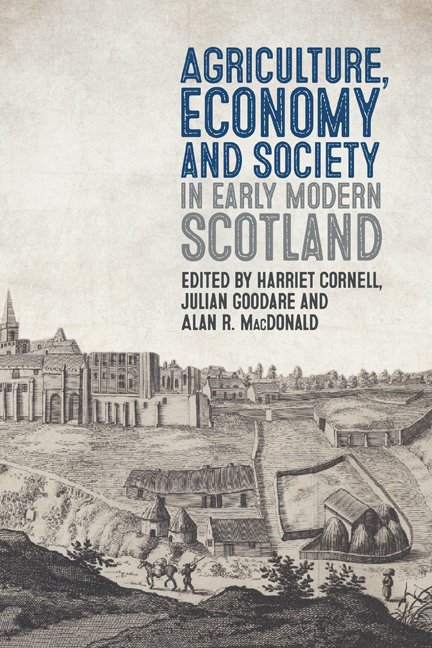Book contents
- Frontmatter
- Dedication
- Contents
- Illustrations
- Contributors
- Acknowledgements
- Note on Currency and Measures
- Abbreviations
- Map of Scotland
- Introduction: Exploring Scotland’s Agricultural History
- 1 Imagining Scottish Agriculture before the Improvers
- 2 The Use of Dykes in Scottish Farming 1500–1700
- 3 The Famine of 1622–23 in Scotland
- 4 Weather and Farming through the Eyes of a Sixteenth-Century Highland Peasant
- 5 Stock, Fermes, Mails and Duties in a Midlothian Barony 1587–89
- 6 The Roots of Improvement: Early Seventeenth-Century Agriculture on the Mains of Dundas, Linlithgowshire
- 7 ‘God Knowis my Sleipis ar Short and Unsound’: Andro Smyth’s Collection of Rent, Tax, Teind and Tolls in Shetland c.1640
- 8 Farming in the Stirling Area 1560–1750
- 9 What Were the Fiars Prices Used For?
- 10 Agriculture and Banking in Eighteenth-Century Scotland 1695–1750
- 11 Capitalism’s Cradle? Ideas, Policies and the Rise of the Scottish Economy in the Mercantilist Age 1600–1800
- Conclusion: A Historiographical and Bibliographical Overview
- Index
- Boydell Studies in Rural History
6 - The Roots of Improvement: Early Seventeenth-Century Agriculture on the Mains of Dundas, Linlithgowshire
Published online by Cambridge University Press: 14 May 2024
- Frontmatter
- Dedication
- Contents
- Illustrations
- Contributors
- Acknowledgements
- Note on Currency and Measures
- Abbreviations
- Map of Scotland
- Introduction: Exploring Scotland’s Agricultural History
- 1 Imagining Scottish Agriculture before the Improvers
- 2 The Use of Dykes in Scottish Farming 1500–1700
- 3 The Famine of 1622–23 in Scotland
- 4 Weather and Farming through the Eyes of a Sixteenth-Century Highland Peasant
- 5 Stock, Fermes, Mails and Duties in a Midlothian Barony 1587–89
- 6 The Roots of Improvement: Early Seventeenth-Century Agriculture on the Mains of Dundas, Linlithgowshire
- 7 ‘God Knowis my Sleipis ar Short and Unsound’: Andro Smyth’s Collection of Rent, Tax, Teind and Tolls in Shetland c.1640
- 8 Farming in the Stirling Area 1560–1750
- 9 What Were the Fiars Prices Used For?
- 10 Agriculture and Banking in Eighteenth-Century Scotland 1695–1750
- 11 Capitalism’s Cradle? Ideas, Policies and the Rise of the Scottish Economy in the Mercantilist Age 1600–1800
- Conclusion: A Historiographical and Bibliographical Overview
- Index
- Boydell Studies in Rural History
Summary
Sir Walter Dundas of that ilk (1562–1636) was a politically prominent laird who represented Linlithgowshire numerous times in parliament, served as its sheriff and was convener of the county's commissioners of the peace. He was also a diligent manager of his estates. His surviving estate records, while sometimes frustratingly fragmentary, contain a wealth of material that sheds light on how agriculture was overseen on a lowland Scottish estate in the early seventeenth century.
Dundas's lands, spread across five neighbouring parishes (Abercorn, Dalmeny, Linlithgow, Livingston and Kirkliston), included some of the best arable land in Scotland. Previous research has shown that, by the middle of the seventeenth century, the mains of Dundas (the farmland directly worked for the laird) was intensively cultivated, with an unusually high proportion of wheat grown alongside oats and bere, as well as significant quantities of legumes, the nitrogen-fixing properties of which permitted even more intensive cultivation. That intensity is demonstrated by the fact that around 85 per cent of the mains was under cultivation every year. Only a relatively small proportion of that land (c.30 per cent) was designated as outfield, and even that was relatively intensively cultivated with more than half of it under crops, compared to the norm of around one-third. The estate has been the subject of detailed research, largely focused on the period from the middle of the seventeenth century onwards, so an examination of earlier records has the potential to provide further insights into a period of Scottish agricultural history that remains largely unexplored.
* * *
This study is based on a number of surviving estate records which suggest that, by the early seventeenth century, cultivation on the mains of Dundas was already a highly-organised operation. Its detailed records comprehend a whole range of activities including the sowing, harvesting, storage and disbursement of crops, as well as expenditure on labour, infrastructure and equipment. While there are few long sequences of any particular type of record, those that are preserved give a strong impression of systematic record-keeping. The extent to which this was typical for its time has yet to be clearly established, although there is no particular reason to suppose that Dundas was unique.
- Type
- Chapter
- Information
- Agriculture, Economy and Society in Early Modern Scotland , pp. 147 - 163Publisher: Boydell & BrewerPrint publication year: 2024



